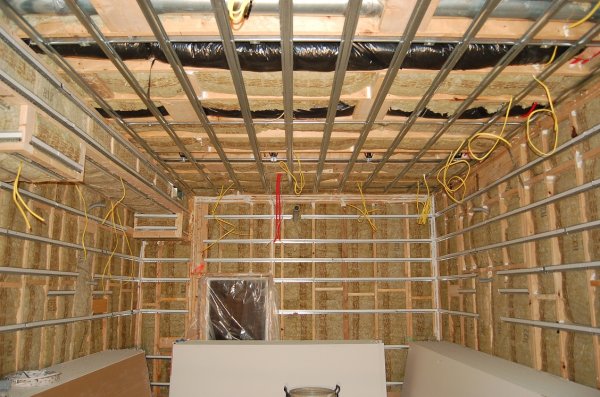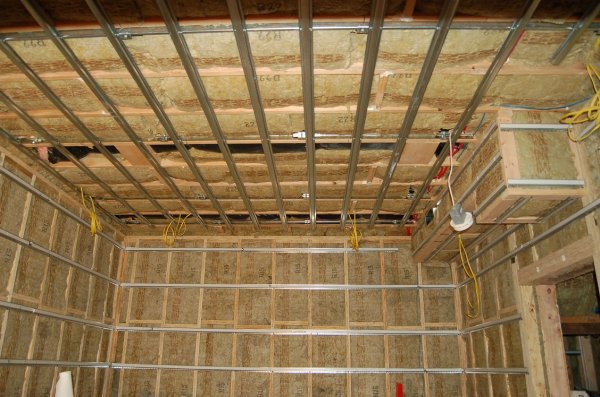Any better isolation technique than Resilient channel and Green Glue?
- Thread starter caesar
- Start date
You are using an out of date browser. It may not display this or other websites correctly.
You should upgrade or use an alternative browser.
You should upgrade or use an alternative browser.
I am not familiar with the above mentioned products, the best I have found are my large wooden-pocks from Harmonix.
Here's their site:
http://www.greengluecompany.com/dealingWithImpactNoise.php
We use all dRC from ASC as well as 27 cases of Green Glue. The glue was not only applied between layers of drywall, but between all wooden joints and then screwed. No nails were used in all the engineered lumber. I also used 23 cases of acoustical caulking on all seams of floor/ceiling joists and wall studs. It was about a 2 1/2 yr. build.
As you can see, the ceiling is on Kinetics Noise Control spring hangers that were mounted according to the estimated weight in a predetermined location. What you're also looking at is a room within a room. There are about 3" between the inner and outer room. The 2 back walls are 3 layers.
We had a drummer hitting 130dB peaks in there one day and you couldn't hear it upstairs or outside. The stuff works!!
As you can see, the ceiling is on Kinetics Noise Control spring hangers that were mounted according to the estimated weight in a predetermined location. What you're also looking at is a room within a room. There are about 3" between the inner and outer room. The 2 back walls are 3 layers.
We had a drummer hitting 130dB peaks in there one day and you couldn't hear it upstairs or outside. The stuff works!!
Attachments
+1. Looks very much like my media room in construction, right down to the black-wrapped ducts and soffet that caused a lot of extra work! I also used Kinetics (Isomax clips).
That is certainly the standard approach. Keep in mind that while using green glue with dual layer of drywall helps with sound isolation, it will degrade your bass performance due to stiffer walls which do not absorb bass as well. A better approach is room within a room in which case, you don't need the green glue.
Keep in mind that while using green glue with dual layer of drywall helps with sound isolation, it will degrade your bass performance due to stiffer walls which do not absorb bass as well.
Which is why we used Snap-tex/OC 703 over the drywall. Over 1/3rd of the cubic volume was taken up by bass trapping!
This is getting exciting, it looks like Caesar is getting ready to go full bore!
Don't forget to document your build my friend, I wish I had taken much more pictures of mine and regret not doing so.
Don't forget to document your build my friend, I wish I had taken much more pictures of mine and regret not doing so.
We use all dRC from ASC as well as 27 cases of Green Glue. The glue was not only applied between layers of drywall, but between all wooden joints and then screwed. No nails were used in all the engineered lumber. I also used 23 cases of acoustical caulking on all seams of floor/ceiling joists and wall studs. It was about a 2 1/2 yr. build.
As you can see, the ceiling is on Kinetics Noise Control spring hangers that were mounted according to the estimated weight in a predetermined location. What you're also looking at is a room within a room. There are about 3" between the inner and outer room. The 2 back walls are 3 layers.
We had a drummer hitting 130dB peaks in there one day and you couldn't hear it upstairs or outside. The stuff works!!
Thanks, Bruce. What is the black wrapping on the HVAC?
Thanks, Bruce. What is the black wrapping on the HVAC?
Kinetics Noise Control did the ventilation system. It's insulation wrapping around the ducts called "Lagging Material".
I also have complete architectural plans drawn up for my media room. It uses alternating studs, so that the inner "room" is not connected to the same studs as the outer room. Green Glue also in between dual floor layers and on ceiling as well. I was expecting to use a lot of ASC tube traps, etc. if the bass needed control.
There are also flexible, somewhat-soft air ducts available. These can be run in an "S" shape, etc., so that the noise from the blower is effectively reduced in the room, and no resonant "steel-drum" effect is possible from the duct-work.
Lee
There are also flexible, somewhat-soft air ducts available. These can be run in an "S" shape, etc., so that the noise from the blower is effectively reduced in the room, and no resonant "steel-drum" effect is possible from the duct-work.
Lee
I isolated my media room from the house HVAC and added a dedicated mini-split unit. HVAC is the wink link in many home media room sound schemes.
Caesar,
The proper answer to your question is YES, NO and MAYBE. Isolation systems should be designed to a target that is first defined by proper analysis of site conditions, intended usage and intended results. Resilient channel is a thread topic all of it's own. A single connection channel such as RC-1 has certain properties, benefits and limitations that can be useful. More often, I prefer an isolation clip that secures a hat channel. The Kinetics isolation products already mentioned are great and I use them frequently.
Green Glue, which I also use, offers constrained layer damping (CLD) and that is an entirely different topic than channel.
What is tough in this area is how each manufacturer shows different data (or data differently). It really does take some experience to know what an "apple to apple" comparison is. It is also tough to focus on single number qualifiers, like STC, as they are intended for typical residential uses and don't indicate the greater LF energy, impact and SPL's that are part of a dedicated listening room. You need to focus on the individual TL numbers across the spectrum. That said, there is a general range of results that is safe to expect by using systems described already. You certainly need mass, air-tight construction and attention to all flanking paths to obtain proper sound transmission control.
If you are intending a double stud partition, you would not likely require a channel. If you are working from a single stud partition system, channel is likely a good part of effective isolation.
The benefits of CLD go beyond just the TL (transmission loss) and bridge into internal room modal damping and diminished "after" resonance of the wallboard itself= tighter, smoother, punchier.
How specific the isolation system should be is going to be directly related to (again) the site conditions, the usage and your goals.
The proper answer to your question is YES, NO and MAYBE. Isolation systems should be designed to a target that is first defined by proper analysis of site conditions, intended usage and intended results. Resilient channel is a thread topic all of it's own. A single connection channel such as RC-1 has certain properties, benefits and limitations that can be useful. More often, I prefer an isolation clip that secures a hat channel. The Kinetics isolation products already mentioned are great and I use them frequently.
Green Glue, which I also use, offers constrained layer damping (CLD) and that is an entirely different topic than channel.
What is tough in this area is how each manufacturer shows different data (or data differently). It really does take some experience to know what an "apple to apple" comparison is. It is also tough to focus on single number qualifiers, like STC, as they are intended for typical residential uses and don't indicate the greater LF energy, impact and SPL's that are part of a dedicated listening room. You need to focus on the individual TL numbers across the spectrum. That said, there is a general range of results that is safe to expect by using systems described already. You certainly need mass, air-tight construction and attention to all flanking paths to obtain proper sound transmission control.
If you are intending a double stud partition, you would not likely require a channel. If you are working from a single stud partition system, channel is likely a good part of effective isolation.
The benefits of CLD go beyond just the TL (transmission loss) and bridge into internal room modal damping and diminished "after" resonance of the wallboard itself= tighter, smoother, punchier.
How specific the isolation system should be is going to be directly related to (again) the site conditions, the usage and your goals.
Similar threads
- Replies
- 19
- Views
- 1K
- Replies
- 2
- Views
- 170
- Replies
- 4
- Views
- 2K
- Replies
- 34
- Views
- 4K
| Steve Williams Site Founder | Site Owner | Administrator | Ron Resnick Site Owner | Administrator | Julian (The Fixer) Website Build | Marketing Managersing |



